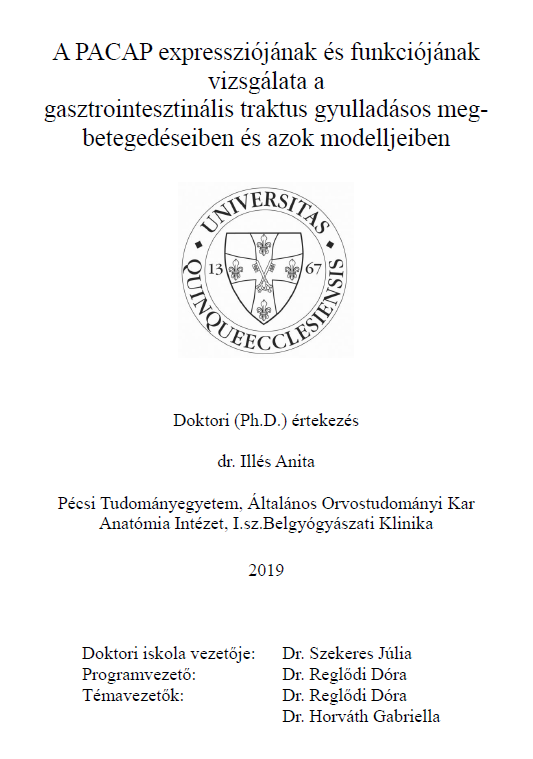A PACAP expressziójának és funkciójának vizsgálata a gasztrointesztinális traktus gyulladásos megbetegedéseiben és azok modelljeiben
Abstract
Pituitary adenylate cyclase-activating polypeptide (PACAP) is a neuropeptide belonging to the secretin/glucagon/vasoactive intestinal peptide family. It was first identified in ovine hypothalamus based on the efficacy on influencing adenylate cyclase activity. PACAP has a widespread distribution in the body and exerts a wide range of physiological effects also in the gastrointestinal system. The occurrence and functions of PACAP and its receptors can be well demonstrated in neuroendocrine and interstitial cells, in the myenteric and submucosal plexus in the entire length of the gastrointestinal tract and also pancreas, gall bladder and liver. PACAP exerts a variety of functions in the intestine. PACAP influences motility of the intestinal wall, inhibits pacemaker activity of interstitial cells of Cajal, regulates sphincter function, affects on secretion of various glands and gastric acid. PACAP exerts relaxant activity in the body and fundus of the stomach and PACAP-immunoreactive fibers are often observed around and in the walls of blood vessels. The general vasodilatory action of PACAP is well established in several species and experimental models. This was also described for the stomach wall. Several in vivo and in vitro studies confirmed the general cytoprotective, antiapoptotic, antioxidant, and anti-inflammatory effects of PACAP. These effects are exerted mainly through G protein-coupled receptors, the specific PAC1 and the VPAC1/2 receptors, which are shared with VIP. In the intestinal system, PACAP has been shown to be protective in various models of intestinal injuries, such as ischemia-reperfusion, transplantation and inflammatory disorders. In small intestinal ischemia, both endogenous and exogenous PACAP have been shown to have protective effects. The anti-inflammatory activity of PACAP can be ascribed to inhibition of immune and inflammatory cells. PACAP decreases the release of inflammatory chemokines and cytokines such as TNF- and IL-6, inhibits chemotaxis and phagocytosis. Hence, it is an important endogenous immunomodulatory peptide in many different models of inflammatory diseases. In humans, several studies have previously shown PACAP level changes in colon diseases. An earlier study found significantly lower levels of PACAP in sigmoid colon and rectum tumors compared to normal healthy tissue. Another study described significantly higher PACAP levels in patients with symptomatic diverticular disease. On the contrary, investigations of colon mucosa of children with ulcerative colitis found decreases in nerve fibers containing PACAP. In case of acute ileitis caused by experimental Toxoplasma gondii infection in mice, PACAP prophylaxis improved survival and anti-inflammatory cytokine response. A recent study has revealed direct antimicrobial effect of PACAP38 against Gram-positive and Gram-negative bacteria. All these results indicate that PACAP influences directly and indirectly the intestinal flora and bacterial colonization, which might be a link with increased susceptibility of PACAP deficient mice to intestinal inflammatory diseases and tumors. PACAP deficient mice have been shown to be more vulnerable to harmful stimuli to the central nervous system, but also peripheral organs including peripheral nerves, kidney, and the intestinal tract. For instance, applying the acute dextran sodium sulfate (DSS)-induced colitis model, PACAP deficient mice displayed 50% higher mortality rates as compared to wildtype mice. In addition, PACAP deficient mice were suffering from more severe chronic DSS-induced colitis, whereas 60% of diseased animals additionally developed colorectal tumors with aggressive phenotypes. Interestingly, naive PACAP deficient mice did not display histopathological changes in their intestinal mucosa. Hence, lack of endogeneous PACAP resulted in increased susceptibility of the murine host to intestinal inflammation and inflammation-induced colonic cancer development.
There is compelling evidence that the host microbiota constitutes a key factor in health and disease of vertebrates. In fact, it has been shown that the gut microbiota is essentially involved in a multitude of physiological processes including food digestion, fat metabolism, vitamin synthesis, intestinal angiogenesis, enteric nerve function, and protection from pathogens as well as immune cell development. Conversely, pertubations of this complex intestinal ecosystem termed dysbiosis are associated with increased susceptibility of the host to distinct intestinal (e.g., inflammatory bowel disease, irritable bowel syndrome, coeliac disease) as well as to extra-intestinal immunopathological conditions (e.g., multiple sclerosis, autism, depression, allergy, asthma, cardiovascular morbidities).

